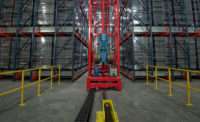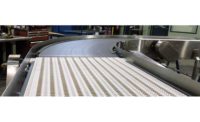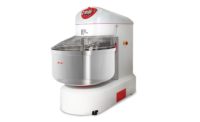Optimized efficiency is a moving target. That’s why terms like “continuous improvement” enter into discussions related to snack and bakery operations on a regular basis.
Whether building a snack production facility or bakery from scratch, or seeking to update a legacy facility, several key areas merit consideration in order to improve efficiency and throughput. And incrementally automating labor-intensive tasks is an ideal starting point.
Primary solutions
“Typically, we find that primary packaging operations are still utilizing a lot of manual labor,” says Craig Souser, president, JLS Automation, York, PA. “Those functions include loading flow wrappers, cartons, thermoformers and so on. Many bakery products are fragile and require gentle handling, which has typically been a challenge for automation.”
However, the industry continues to streamline and improve automation to meet the needs of snack producers and bakers. “Utilizing robotics to load these primary packages helps increase throughput and efficiencies,” says Souser. “Because of the placement accuracy and speed at which robotic systems can place products into packages, bakery producers are starting to consider this type of automation.”
Advancements to end-of-arm tooling (EOAT) have opened the door to automation for a wider range of snack and bakery products. “There have been significant improvements in end-of-arm robotic tooling that can handle naked products gently,” says Souser. “A great example is a tool we recently developed to load loaves of fresh sliced bread into a thermoformer for MAP packaging. Handling a delicate loaf of bread was difficult in itself, but being sliced adds a whole new challenge. This new tool not only gently handles the product, but it controls it faster than a line worker can—again, because it’s sliced and is not always easy to keep intact, especially if you’re trying to achieve higher speeds.”
Historically, robotic automation has been a productive solution for standardized items, says Carl Vause, CEO, Soft Robotics, Cambridge, MA. “A robotic gripper that picks up the same item that is the same size, at the same speed has been an efficient use of robotics for some time now.”
Where industry innovation has stepped in to improve things in recent years is via improved EOAT to effectively automate difficult tasks—to pick up items that don’t fit within precise parameters, notes Vause. For instance, he notes that balls of pizza dough might have varying degrees of weight and consistency. Also some items, like doughnuts or cupcakes, are delicate and require a soft touch. Having the right robotic solutions to handle these times does much to streamline primary packaging.
One of the driving forces for adding automation is the severe labor shortage in the industry, notes Vause. “I’ve spoken to countless snack and bakery facility owners and managers who are forced to introduce automation because of their inability to hire and retain workers.”
Automation of primary packaging is an area that is just beginning to improve through unique grippers, notes Vause. “Individual pieces are the most difficult to handle in the bakery world, because they are all slightly unique—too nonstandard for traditional automation options. Today, you can have one gripper pick up a cupcake and then pick up a bagel or another item with a single gripping process in place. That’s pretty revolutionary.”
Collaborative options
Stan Prutz, president and CEO, QDS Systems, Baton Rouge, LA, notes that pan-handing is often a highly inefficient aspect of production. “Most snack and bakery facilities are already using some sort of traditional automation solution. However, we’re seeing that traditional vendors are typically slow to put the latest automation upgrades/innovations like robotics into their products. Robotics has significant potential to be used in pan stacking/unstacking, lid lines and packaging. Collaborative robots can potentially be used as helpers to human workers, as they can be safely placed side-by-side with existing employees. Many of these robots are light and powered by 120-volt wall power, allowing them to be deployed for short-term needs, rather like a temporary workforce.”
Industry leaders are often more open to experimenting with new automation trends, such as collaborative robotics, suggests Prutz. “The leaders continuously upgrade their systems so they are as efficient as possible. Those who don’t invest in upgrades typically fall behind to the point where they can’t ever catch up to the competition.”
This ties back to the need for continuous improvement and never resting on your laurels. “The key is to continue to invest in your facility—even if it’s just a little each year—so you don’t get into a downward spiral,” recommends Prutz. “If facilities don’t set aside money for automation improvements, they won’t be able to afford it down the road. They’ve waited so long that they now have higher costs than their competition, they’re not efficient and end up losing business.”
End-of-line efficiency
“The snack and bakery facilities that I have been involved with tend to be rather inefficient on the end-of-line, where they often are required to pack a wide variety of different SKUs for club stores and other special packs,” says Peter Fox, senior vice president of sales, Somic America, Eagan MN. “The end-of-line operation can be managed with manual operations, and is seen as pretty flexible.” However, this is becoming a challenge in light of the problematic labor shortages seen in the industry.
The challenge is to introduce flexible levels of automation. “Manual operators can change a pack pattern very quickly. Automation requires some rationalization of unique and perhaps some smaller-volume SKUs. Automation must also have the ability to change with the market requirements without breaking the bank, so there are definitely some compromises and tradeoffs as you move from a manual operation to a fully automated system.”
Robotics provide a significant gain in efficiency for palletizing in snack and bakery operations, notes Fox. “With the significant improvements in product handling with robots, the handling and manipulation of products into flow wrappers or cartoners is becoming more common. Automation in general can provide for much better consistency in the finished product.”
For such operations, Fox points out that the same automation that provides end-of-line consistency also requires a certain level of consistency from upstream production. “Automation will expose wide product variability and will require more consistency from all the operational systems,” he says. “As automation increases, the demand for repeatable quality and consistency will naturally drive continuous improvement.”






